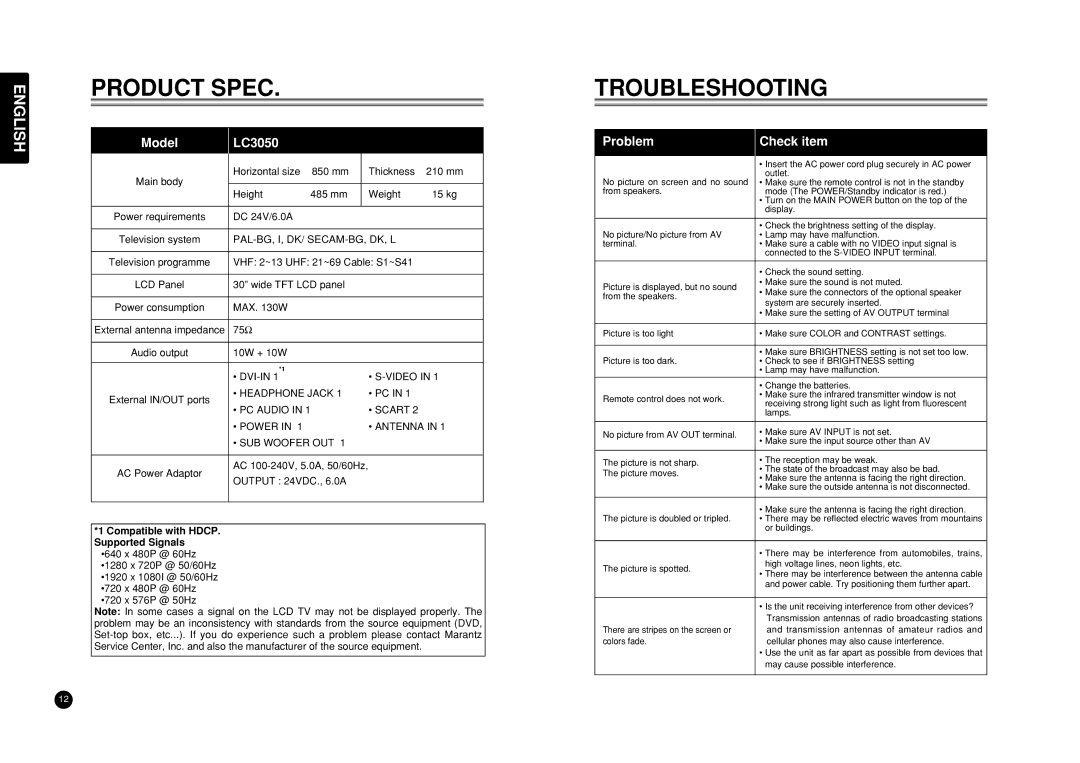
ENGLISH
PRODUCT SPEC.
Model | LC3050 |
|
|
|
|
Main body | Horizontal size | 850 mm |
| Thickness | 210 mm |
|
|
|
|
| |
Height | 485 mm |
| Weight | 15 kg | |
|
| ||||
|
|
|
|
|
|
Power requirements | DC 24V/6.0A |
|
|
|
|
|
|
|
| ||
Television system |
|
| |||
|
|
|
| ||
Television programme | VHF: 2~13 UHF: 21~69 Cable: S1~S41 |
| |||
|
|
|
|
| |
LCD Panel | 30” wide TFT LCD panel |
|
| ||
|
|
|
|
|
|
Power consumption | MAX. 130W |
|
|
|
|
|
|
|
|
|
|
External antenna impedance | 75Ω |
|
|
|
|
|
|
|
|
|
|
Audio output | 10W + 10W |
|
|
|
|
|
|
|
|
|
|
| *1 |
|
| • | |
| • |
|
| ||
External IN/OUT ports | • HEADPHONE JACK 1 | • PC IN 1 |
| ||
• PC AUDIO IN 1 | • SCART 2 |
| |||
|
| ||||
| • POWER IN 1 |
|
| • ANTENNA IN 1 | |
| • SUB WOOFER OUT 1 |
|
| ||
|
|
|
|
| |
AC Power Adaptor | AC |
|
| ||
OUTPUT : 24VDC., 6.0A |
|
| |||
|
|
| |||
|
|
|
|
|
|
*1 Compatible with HDCP. Supported Signals
•640 x 480P @ 60Hz •1280 x 720P @ 50/60Hz •1920 x 1080I @ 50/60Hz •720 x 480P @ 60Hz •720 x 576P @ 50Hz
Note: In some cases a signal on the LCD TV may not be displayed properly. The problem may be an inconsistency with standards from the source equipment (DVD,
TROUBLESHOOTING
Problem | Check item | |
|
| |
| • Insert the AC power cord plug securely in AC power | |
No picture on screen and no sound | outlet. | |
• Make sure the remote control is not in the standby | ||
from speakers. | mode (The POWER/Standby indicator is red.) | |
| • Turn on the MAIN POWER button on the top of the | |
| display. | |
|
| |
| • Check the brightness setting of the display. | |
No picture/No picture from AV | • Lamp may have malfunction. | |
terminal. | • Make sure a cable with no VIDEO input signal is | |
| connected to the | |
|
| |
| • Check the sound setting. | |
Picture is displayed, but no sound | • Make sure the sound is not muted. | |
• Make sure the connectors of the optional speaker | ||
from the speakers. | ||
system are securely inserted. | ||
| ||
| • Make sure the setting of AV OUTPUT terminal | |
|
| |
Picture is too light | • Make sure COLOR and CONTRAST settings. | |
|
| |
Picture is too dark. | • Make sure BRIGHTNESS setting is not set too low. | |
• Check to see if BRIGHTNESS setting | ||
| • Lamp may have malfunction. | |
|
| |
| • Change the batteries. | |
Remote control does not work. | • Make sure the infrared transmitter window is not | |
receiving strong light such as light from fluorescent | ||
| ||
| lamps. | |
|
| |
No picture from AV OUT terminal. | • Make sure AV INPUT is not set. | |
• Make sure the input source other than AV | ||
| ||
|
| |
The picture is not sharp. | • The reception may be weak. | |
• The state of the broadcast may also be bad. | ||
The picture moves. | ||
• Make sure the antenna is facing the right direction. | ||
| ||
| • Make sure the outside antenna is not disconnected. | |
|
| |
The picture is doubled or tripled. | • Make sure the antenna is facing the right direction. | |
• There may be reflected electric waves from mountains | ||
| or buildings. | |
|
| |
| • There may be interference from automobiles, trains, | |
The picture is spotted. | high voltage lines, neon lights, etc. | |
• There may be interference between the antenna cable | ||
| ||
| and power cable. Try positioning them further apart. | |
|
| |
| • Is the unit receiving interference from other devices? | |
| Transmission antennas of radio broadcasting stations | |
There are stripes on the screen or | and transmission antennas of amateur radios and | |
colors fade. | cellular phones may also cause interference. | |
| • Use the unit as far apart as possible from devices that | |
| may cause possible interference. | |
|
|
12
